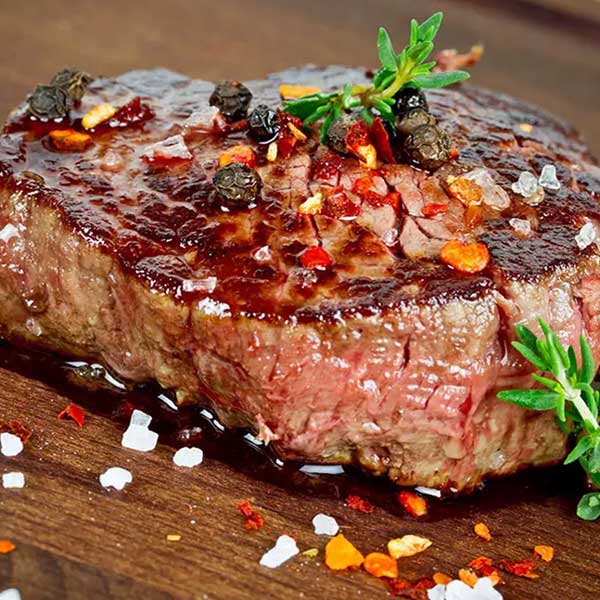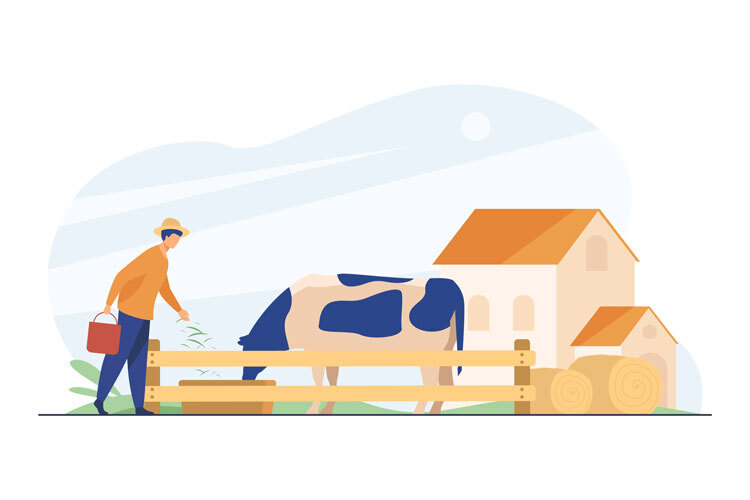Grass-fed and pasture-raised meats have grown in popularity in recent years. Grass-fed means the animals ate only grass and other foraged plants after they were weaned from their mother’s milk. Pasture-raised implies the animals had access to and primarily grazed on pastureland.
Consumer interest in grass-fed and pasture-raised meats has expanded for several reasons. Many believe these products are healthier, more natural, better for the environment, and more ethical than conventionally-raised meat. However, there are also many myths and misconceptions about grass-fed and pasture-raised.
The goal of this article is to debunk some of the most common myths surrounding grass-fed and pasture-raised meat. We’ll examine the facts behind the marketing claims and clear up any confusion about how grass-fed meats compare to conventional meat in terms of nutrition, taste, sustainability, and more. With a better understanding of the realities of grass-fed, you can determine if it fits your needs and values.
Myth 1: Grass-Fed Meat is Not Healthier
One of the most common myths about grass-fed meat is that it’s no healthier than conventional grain-fed meat. However, research shows that meat from cattle raised on pasture and grasslands offers significant nutritional advantages.
Grass-fed beef is higher in key nutrients like omega-3 fatty acids and conjugated linoleic acid (CLA). Studies show grass-fed meat contains 2-4 times more omega-3s than grain-fed beef. Omega-3s are linked to reduced inflammation and heart health. Grass-fed meat also provides more CLA, which is associated with anti-cancer properties.
In addition, grass-fed beef is higher in antioxidants like vitamin E and beta-carotene. It also provides significantly more B vitamins, vitamin A and vitamin K. These vitamins are important for immune function, blood clotting, bone health and vision. Grass-fed meat also contains higher levels of glutathione and superoxide dismutase, two powerful antioxidants.
Overall, numerous studies have confirmed that grass-fed beef is better for you than conventional beef. It has a healthier nutritional profile with more anti-inflammatory fats, vitamins, minerals and antioxidants. So the notion that it’s not any healthier simply doesn’t hold up to scientific scrutiny. When it comes to nutritional quality, grass-fed beef is clearly the winner.
Myth 2: Grass-Fed Meat Doesn't Taste as Good
While some assume that grass-fed beef lacks flavour and tenderness compared to grain-fed, the taste difference is often exaggerated. Grass-fed cattle enjoy a diverse diet of grasses, herbs, and other forage that imparts a more complex, nuanced flavour profile. The varied diet contributes to the distinct “grassy” and earthy essence grass-fed beef is known for.
When raised properly on a pasture-based diet, grass-fed beef can develop marbling in moderation. While leaner overall than grain-finished beef, strategic finishing on high-quality forage can ensure adequate intramuscular fat for moisture, tenderness and yes, beefy flavour. The key is slow, natural growth and maturation on pasture.
Lastly, proper cooking remains paramount for optimizing flavour and texture, regardless of how the animal was raised. Lower-and-slower cooking methods allow moisture to be retained and connective tissues to break down. While grass-fed beef is often praised for its health merits, it should not be overlooked for its full-bodied taste and satisfying eating experience in the hands of a good cook. Once any preconceived biases are shaken, the rich depth of flavour grass-fed beef offers can be appreciated.
Myth 3: It's Not Natural for Cows to Eat Grass
One common myth is that eating grass is unnatural for cows. However, the evolutionary history and biology of cows tells a different story.
Cows are ruminants, which means they have a specialized digestive system designed to digest fibrous grasses and plants. They have a rumen (a large fermentation tank) filled with microbes that break down cellulose and ferment plant materials. This allows them to derive energy and nutrients from grass.
Ruminants like cows evolved as grazing animals over millions of years. Their digestive systems are specifically adapted to eating grasses and plants. In fact, grass makes up the natural, ideal diet for cattle. Eating grass provides the roughage and nutrients that promote good rumen health and keeps their digestive system functioning properly.
When cattle are allowed to graze on open pastures and eat a grass-based diet, they are eating the foods their bodies are designed to digest. Research shows that cattle fed primarily on forages and grasses have healthier rumen pH levels and more diversity in their gut microbiome compared to cattle raised on grain-heavy diets. Their digestive systems function best when they eat what nature intended.
So despite the myth, eating diverse grasses on pasture is actually the most natural diet for cows from an evolutionary and biological perspective. Their bodies are literally built to eat grass. Raising cows on pasture allows them to graze just as they have for thousands of years.
Myth 4: Grass-Fed is Just Marketing Hype
While the “grass-fed” label has certainly been used for marketing purposes, there are valid certification programs with enforced standards and auditing in place to ensure authenticity. For beef to qualify as Certified Grassfed under the American Grassfed Association, for example, strict protocols must be followed. These include:
- Cows must have continuous access to pasture during the growing season and must derive at least 60% of their diet from grazing grass.
- Cows cannot be confined to feedlots and must be raised in a pasture-based system their entire lives.
- Cows cannot be treated with hormones or antibiotics.
- The land used for grazing must be certified organic, or the farmer must have a plan in place to convert the land to organic standards.
Farms must undergo annual audits to retain their grassfed certification. There is third-party oversight and spot testing to verify compliance. Similar standards exist for grassfed labels from Animal Welfare Approved, Food Alliance, and PCO Certified Organic. So while marketing hype exists, there are trustworthy certifiers ensuring authentic, grassfed beef production. The availability of valid certification programs means grass-fed beef can be produced transparently and ethically. It is not just a marketing gimmick.
Myth 5: Grass-Fed is Unsustainable
One common myth is that grass-fed beef is unsustainable compared to conventional feedlot beef. However, this perception is misguided. Grass-fed operations can actually benefit the environment in multiple ways:
- Regenerative grazing – When properly managed, grass-fed cattle can be used as part of a regenerative system that enhances soil health. As the cattle graze, they deposit manure and trample grass and forage into the ground. This cycles nutrients, increases organic matter in soil, and stimulates plant growth. Regenerative grazing can even help capture carbon in the soil.
- Reduced land requirements – Grass-fed cattle utilize partly marginal lands that are not suitable for growing grain or other crops. They also rely primarily on native grasses and forages that do not require inputs like fertilizer. Overall, grass-fed systems require significantly less land and resources than producing corn and other grains to feed cattle in confinement.
- Promoting biodiversity – Rotational and carefully planned grazing mimics the natural impacts ruminants had in ecosystems. This controlled grazing pressure can increase plant diversity and provide habitat for other wildlife species. Diverse grasslands fix carbon, reduce erosion, and support pollinators.
So contrary to myths, well-managed grass-fed beef production can actually provide environmental benefits. When factoring in the reduced dependence on grain monocultures and feedlots, grass-fed cattle can play an integral role in sustainable food systems. The decentralized, regenerative nature of smaller-scale grass-fed operations makes this model resilient and ecologically sound.
Myth 6: Grass-Fed is Low-Yield
It’s true that grass-fed beef typically has lower yields per acre compared to conventional feedlot beef. However, this doesn’t mean there isn’t potential to supply sufficient grass-fed beef to meet market demand.
The key is focusing on quality over quantity. Grass-fed cattle take longer to reach market weight since they gain about 2 pounds per day on pasture, versus 3-4 pounds per day on grain. However, the slower growth allows time for muscles to develop, resulting in better marbling and more flavour. The tradeoff of slightly lower yields is worthwhile for a superior tasting product.
Additionally, improvements in pasture management and rotational grazing can increase the carrying capacity of land used for grass-fed beef production. Well-managed pastures allow cattle to maximize the nutritional value of grasses and legumes, thereby optimizing weight gain from the available forage. With the right practices, grass-fed yields can rival conventional methods.
Rather than trying to force grass-fed systems to match the inflated yields of feedlots, the focus should remain on sustainably producing the highest quality beef possible. When it comes to our food, substance should matter more than size. Grass-fed beef offers a model for humane, regenerative agriculture that values ecology and nutrition over productivity quotas.
Myth 7: Grass-Fed is Always Local
A common assumption is that grass-fed meat always comes from small, local farms. However, this isn’t necessarily the case. While some grass-fed beef does come from small-scale local ranches, there are also larger-scale operations that produce grass-fed meat.
Some of the major grass-fed beef suppliers in the U.S. manage large ranches spanning thousands of acres in multiple states. For example, Verde Farms in Arizona manages around 300,000 acres of land for grass-fed cattle grazing across the Western U.S. So while their beef is 100% grass-fed, it’s not always locally raised for consumers in all regions.
Additionally, meat labeled as grass-fed can sometimes be sourced from Australia, New Zealand, and parts of South America during certain times of year. This is due to the climate and longer grazing seasons available in the Southern Hemisphere.
There are certainly great benefits to supporting local farmers and ranchers. However, grass-fed beef shouldn’t be assumed to always come from a small producer down the road. When it’s important to consumers, the origin and scale of operation should be investigated further than just the grass-fed label. Though not guaranteed, localized grass-fed beef can potentially be sought out through farmers markets, CSAs, and direct-to-consumer relationships with individual farms.
Myth 8: Grass-Fed is Too Expensive
Grass-fed meat is often more expensive than conventional feedlot-raised meat, but this doesn’t mean it is unaffordable or not a smart investment for your health and the environment.
The main reasons grass-fed costs more are lower government subsidies compared to conventional feedlot farming, and slightly lower yields per acre on well-managed grass-fed operations. However, when accounting for the health, environmental, and animal welfare benefits, many feel the added cost is worthwhile.
Several factors help make grass-fed a smart economic choice:
- Per pound, grass-fed contains more nutrition including healthy fats like omega-3s and antioxidants. So even though the price per pound is higher, the nutritional value is also greater.
- By choosing grass-fed you support farmers who use regenerative practices that improve soil, water, and land resources for future generations. This provides added economic value not captured in the retail price.
- When produced on a local and regional scale, grass-fed operations help circulate dollars through the community. This boosts the local economy versus sending money to large consolidated feedlot operations.
- The premium for grass-fed has fallen considerably over the past decade as demand has grown. Many local ranchers now offer competitive bulk pricing.
- Pasture-raised chickens and pigs generally have a smaller price premium over factory farmed options. Expanding your diet to diverse grass-fed meat can help lower costs.
So while grass-fed meat has a justifiably higher price tag, it delivers outstanding value. With care in selecting more budget-friendly cuts, varieties, and buying in bulk, grass-fed meat can be an economical part of an ethical, healthy, and sustainable diet.
The evidence shows that grass-fed and pasture-raised meat offers significant benefits compared to conventional meat, despite some common myths and misconceptions. Grass-fed meat contains more omega-3s and other nutrients, has a favourable fat profile, and avoids many of the ethical issues around factory farming. While grass-fed meat is often slightly more expensive and not always local, the overall benefits for nutrition, animal welfare, and sustainability make it an optimal choice for many consumers.
Grass-fed meat is demonstrably healthier, with higher levels of heart-healthy fats and antioxidants, as well as a more balanced ratio of omega-3 to omega-6 fatty acids. Studies show grass-fed beef is just as delicious as grain-fed to most consumers in blind taste tests. It’s also more natural and optimal for cows to graze on grass instead of being fattened on grains in crowded feedlots. The grass-fed label is more than just hype or marketing – it indicates meaningful differences in how the animals were raised and what they ate. While yields are typically lower, grass-fed and pastured systems can be just as sustainable, if not more so, than conventional methods.
In summary, grass-fed and pasture-raised meat debunks many of the myths surrounding it. For conscious consumers focused on nutrition, ethical farming practices, and environmental sustainability, it represents an optimal choice despite slightly higher costs. The evidence is clear that the benefits outweigh the drawbacks for most health- and eco-minded meat eaters.







